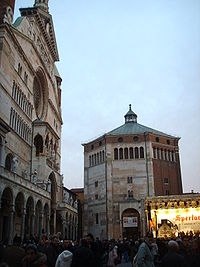
Cremona Baptistery
Encyclopedia

Cremona
Cremona is a city and comune in northern Italy, situated in Lombardy, on the left bank of the Po River in the middle of the Pianura Padana . It is the capital of the province of Cremona and the seat of the local City and Province governments...
, northern Italy
Italy
Italy , officially the Italian Republic languages]] under the European Charter for Regional or Minority Languages. In each of these, Italy's official name is as follows:;;;;;;;;), is a unitary parliamentary republic in South-Central Europe. To the north it borders France, Switzerland, Austria and...
. It is annexed to the city's Cathedral
Cremona Cathedral
The Duomo di Cremona , dedicated to Santa Maria Assunta , is a church in Cremona, Lombardy, northern Italy and the episcopal see of the Roman Catholic Diocese of Cremona...
.
Built in 1167, it is characterized by an octagonal plan, a reference to the cult of St. Ambrose of Milan
Milan
Milan is the second-largest city in Italy and the capital city of the region of Lombardy and of the province of Milan. The city proper has a population of about 1.3 million, while its urban area, roughly coinciding with its administrative province and the bordering Province of Monza and Brianza ,...
, symbolizing the Eight Day of Resurrection and, thenceforth, the Baptism.
The edifice mixes Romanesque
Romanesque architecture
Romanesque architecture is an architectural style of Medieval Europe characterised by semi-circular arches. There is no consensus for the beginning date of the Romanesque architecture, with proposals ranging from the 6th to the 10th century. It developed in the 12th century into the Gothic style,...
and Lombard-Gothic
Gothic architecture
Gothic architecture is a style of architecture that flourished during the high and late medieval period. It evolved from Romanesque architecture and was succeeded by Renaissance architecture....
styles, the latter evident in the preference for bare brickwork walls. To the 16th century restorations belong the marble cover of some walls, the pavement and the baptismal font (1531) and the narthex
Narthex
The narthex of a church is the entrance or lobby area, located at the end of the nave, at the far end from the church's main altar. Traditionally the narthex was a part of the church building, but was not considered part of the church proper...
(1588) of the entrance, in Romanesque style, work by Angelo Nani.
The interior has a 14th century Crucifix, over the St. John altar, and two wooden statues portraying "St. Philip Neri" and "St. John the Baptist" by Giovanni Bertesi. Over the ceiling is a 12th century statue of the Archangel Gabriel.

